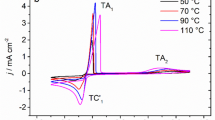Abstract
Voltammetry and electrochemical impedance spectroscopy were applied to investigate the inhibition activity of ethyleneglycol and its oligomers on tin electrode in strong acidic sulfate solutions. Tetraethyleneglycol was found to be the most active substance among compounds HO–(CH2–CH2–O) m –H (m≤4) that retards diffusion-controlled Sn(II) reduction due to its inhibitive adsorption. This rather slow process is controlled both by diffusion and electrosorption steps. A comparison of exchange current densities obtained in the presence of different polyethers shows that the length of the hydrocarbon chain is the main factor responsible for inhibition activity of such substances on tin electrode.







Similar content being viewed by others
References
Meibuhr S, Yeager E, Kozawa A, Hovorka F (1963) The electrochemistry of Sn. Effects of nonionic addition agents on electrodeposition from stannous sulfate solutions. J Electrochem Soc 110:190
Galdikienė O, Mockus Z (1994) Cathodic process in copper–tin deposition from sulphate solutions. J Appl Electrochem 24:1009
Mockus Z (1995) Electrochemical codeposition of copper and tin in acid sulphate solutions. Ph.D. Thesis Vilnius
Medvedev GI, Tkachenko NA (1984) Electrodeposition of copper–tin alloy from sulphate electrolyte in the presence of sintanol DS-10. Zashchita Metallov 3:484
Survila A, Mockus Z, Kanapeckaitė S, Samulevičienė M (2002) Adsorption behaviour of laprol 2402 C on copper electrode. Polish J Chem 76:983
Survila A, Mockus Z, Kanapeckaitė S (2002) Adsorption behaviour of laprol 2402 C on a tin electrode. Trans IMF 80:85
Stoychev D, Tsvetanov CJ (1996) Behaviour of poly(ethylene glycol) during electrodeposition of bright copper coatings in sulfuric acid electrolytes. J Appl Electrochem 26:741
Stoychev D, Tsvetanov CJ (1998) On the role of poly(ethylene glycol) in deposition of galvanic copper coatings. Trans IMF 26:73
Survila A, Mockus Z, Kanapeckaitė S (2003) Effect of halides on adsorption properties of polyether laprol 2402 C on copper and tin electrodes. J Electroanal Chem 552:97
Glarum SH, Marshall JH (1983) Admittance study of the Sn electrode. J Electrochem Soc 130:1088
Medvedev GI, Trubnikova ON (1984) Investigation of kinetics of tin electrodeposition from sulphate electrolyte in the presence of sintanol DS-10. Elektrokhimiya 20:846
Survila A, Mockus Z, Kanapeckaitė S, Samulevičienė M (2005) Effect of sintanol DS-10 and halides on tin(II) reduction kinetics. Electrochim Acta 50:2879
Reid JD, David AP (1987) Effects of polyethylene glycol on the electrochemical characteristics of copper cathodes in acid copper medium. Plat Surf Finish 74:66
Bražinskienė D, Survila A (2005) Effect of ethylene glycol and its oligopolymers on the copper(II) electroreduction kinetics in halide-containing acid sulphate solutions. Russ J Electrochem 41:979
Boukamp BA (1989) Equivalent circuits (EQUIVCRT.PAS), users manual. University of Twente, The Netherlands
Bražinskienė D, Survila A, Samulevičienė M (2005) Cu(II) electroreduction kinetics in acidic sulphate solutions containing tetraethyleneglycol and small amounts of chlorides. Chemija (Vilnius) 16:20
Quintin M, Hagymas G (1964) Contribution a l’etude de la corrosion électrochimique de l’étain en milieu sulfurique. J Chim Phys 61:541
Kostryukova GG, Ratkov OI, Kazakov VA, Ginberg AM, Vagramyan AT (1969) On the application of relaxation methods for study of metal electrodeposition processess. I. Electrode Sn/Sn2+. Elektrokhimiya 5:571
Galus Z (1975) Tin. In: Bard AJ (ed) Encyclopedia of electrochemistry of the elements, vol 4. Dekker, New York, pp 223–271
Survila A, Mockus Z, Kanapeckaitė S (2001) Voltammetric characterization of laprol 2402 C adsorption on copper and tin electrodes. Chemija (Vilnius) 12:241
Väärtnõu M, Lust E (2004) Impedance characteristics of iodine ions adsorption on Bi single crystal planes in ethanol. J Electroanal Chem 565:211
Nurk G, Kasuk H, Lust K, Jänes A, Lust E (2003) Adsorption kinetics of dodecyl sulfate anions on the bismuth (011) plane. J Electroanal Chem 553:1
Macdonald JR (1987) Impedance spectroscopy. Wiley, New York
Frumkin AN, Melik-Gaikazyan VI (1951) Determination of the kinetics of adsorption of organic substances by a.-c. measurements of the capacity and the conductivity at the boundary: electrode-solution. Dokl Akad Nauk USSR 77:855
Berzins T, Delahay P (1955) Electrochemical method for the kinetic study of fast adsorption processes. J Phys Chem 59:906
Lorenz W, Möckel F (1956) Adsorptionsisotherme und Adsorptionskinetik kapillaraktiver organischer Molekeln an der Quecksilberelektrode. Z Elektrochem 60:507
Sluyters-Rehbach M, Sluyters JH (1970) Sine wave methods in the study of electrode processes. In: Bard AJ (ed) Electroanal Chemistry, vol 4. Dekker, New York, pp 75–77
Retter U, Jehring H (1973) Untersuchungen der adsorptionskinetik an der phasengrenze quecksilber/elektrolyt durch analoge messung der doppelschichtadmittanz. J Electroanal Chem 46:375
Pajkossy T, Wandlowski Th, Kolb DM (1996) Impedance aspects of anion adsorption on gold single crystal electrodes. J Electroanal Chem 414:209
Jovič VD, Jovič BM (2003) EIS and differential capacitance measurements onto single crystal faces in different solutions: Part I: Ag(111) in 0.01 M NaCl. J Electroanal Chem 541:1
Brug GJ, van den Eeden ALG, Sluyters-Rehbach M, Sluyters JH (1984) The analyses of electrode impedances complicated by the presence of a constant phase element. J Electroanal Chem 176:275
Retter U, Widmann A, Siegler K, Kahlert H (2003) On the impedance of potassium nickel(II) hexacyanoferrate(II) composite electrodes—the generalization of the Randles model referring to inhomogenous electrode materials. J Electroanal Chem 546:87
Acknowledgement
We are grateful to Dr. M. Samulevičienė for her kind assistance in performing impedance measurements.
Author information
Authors and Affiliations
Corresponding author
Rights and permissions
About this article
Cite this article
Survila, A., Bražinskienė, D. Inhibition activity of ethyleneglycol and its oligomers on tin electrode. J Solid State Electrochem 11, 65–70 (2007). https://doi.org/10.1007/s10008-005-0070-2
Received:
Revised:
Accepted:
Published:
Issue Date:
DOI: https://doi.org/10.1007/s10008-005-0070-2




